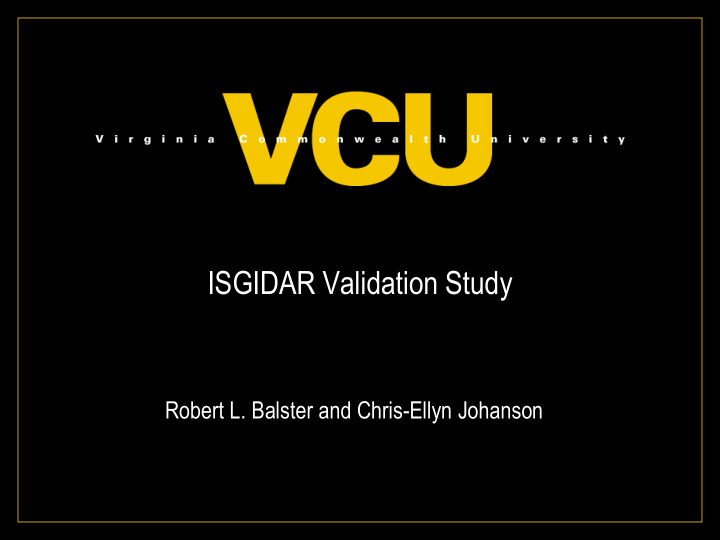



ISGIDAR Validation Study Robert L. Balster and Chris-Ellyn Johanson
Background: The early 1970s • This effort began in the context of the CPDD testing programs for opioid physical dependence that were in operation at the University of Michigan (Maurice Seevers) and Virginia Commonwealth University (Louis Harris). • Value of self-administration studies for abuse potential assessment was recognized early by regulators, pharmaceutical company pharmacologists and the scientific community • Potential for use in regulatory decision making raised the bar for demonstrating the reliability and validity of the approach
Initial Steps • Nathan Eddy suggested reliability/validity study at first ISGIDAR organizational meeting in February 1973 • At May 1973 CPDD meeting Bob Schuster agreed to lead this effort – Assigned it to Chris-Ellyn Johanson and me
Initial Steps • Nathan Eddy suggested reliability/validity study at first ISGIDAR organizational meeting in February 1973 • At May 1973 meeting Bob Schuster agreed to lead this effort – Assigned it to Chris-Ellyn Johanson and me • Curing 1973 Chris-Ellyn developed form for collection of rhesus monkey self-administration results from all ISGIDAR laboratories
Data collection form
Initial Steps • Nathan Eddy suggested reliability/validity study at first ISGIDAR organizational meeting in February 1973 • At May 1973 meeting Bob Schuster agreed to lead this effort • During 1973 Chris-Ellyn developed form for collection of rhesus monkey self-administration results from all ISGIDAR laboratories • In November 1973 Chris-Ellyn presented results of substitution testing for 39 drugs for which data had been provided (Available in ISGIDAR Newsletter, Vol. 2, No. 1, February 1974) which showed excellent reliability.
Cocaine testing in different labs with different baseline drugs
Heroin testing in two labs with codeine or cocaine baseline
Codeine testing in different labs with different baseline drugs
Next Steps • After seeing preliminary results of ISGIDAR data sharing effort, the Study Group decided in November 1973 to obtain data on some classes of drugs that had not been tested and to send out some of the drugs to investigators blinded to the drug’s identity • In March 1974 at ISGIDAR meeting in Mexico City, negative control compounds were selected for study – pyrilamine, atropine and scopolamine, ephedrine, propranalol, pilocarpine, arecoline and physostigmine • Chris-Ellyn continued to coordinate data collection and reporting and by 1977 or so we were ready to write up the results
THE FINAL PRODUCT CE Johanson and RL Balster. A summary of the results of a drug self-administration study using substitution procedures in rhesus monkeys. Bulletin on Narcotics 30(3), pp. 43-54, 1978
Method • Restricted this report to studies using substitution procedures in rhesus moneys where the data were submitted through the ISGIDAR data coordination effort • Results came from 17 study groups representing 9 different laboratories, including 4 in pharmaceutical companies (Abbott, Smith Kline & French, Parke-Davis, Bayer) and one CRO (Yanagita) – Main university labs were in Michigan, Chicago and VCU • Positive self-administration results were compared with human abuse liability – “If more than 50% of the animals self -administered more of the test drug than saline at least at one dose” results were considered positive – Criterion variable was authors’ subjective assessment of whether the drug was abused or not, probably assisted by Bob Schuster
Results • Results provided for over 90 drugs – Included most of the “negative controls” that had been assigned • Tables provided for each class of drug showing drug name, result (Yes or No or Both), testing laboratory and citation (if published) • Exceptional reliability, only chlordiazepoxide, pentazocine and tilidine showed discordant results between testing sites • Several of the drugs which were tested were of unknown abuse liability (azidomorphine, etazocine, GPA 1657, N-propyl amphetamine)
Major Conclusion “Most drugs which maintain responding in animals ( i.e. are positive reinforcers) are considered drugs of abuse in humans. On the other hand, drugs which do not maintain responding are not abused”
* * * * * *
Griffiths, R.R. and Balster, R.L. Opioids: Similarity between evaluations of subjective effects and animal self-administration results. Clinical Pharmacology and Therapeutics 25 :611-617, 1979.
Main Conclusion Taken together, results of ISGIDAR validity and reliability study were important in establishing i.v. self-administration procedures as useful for abuse-liability assessment.
Another Outcome
Recommend
More recommend